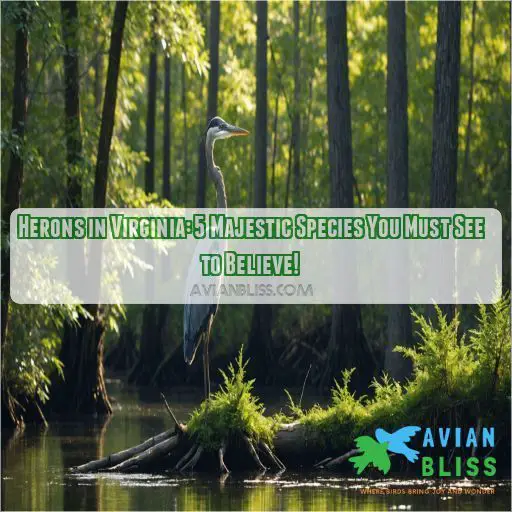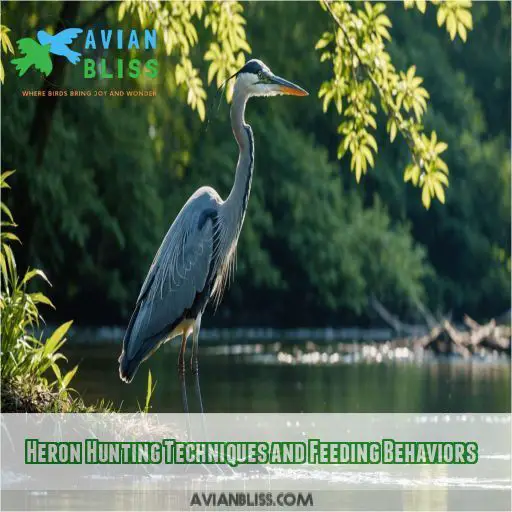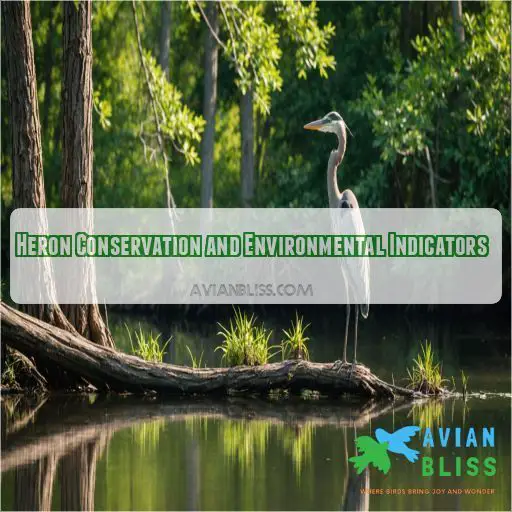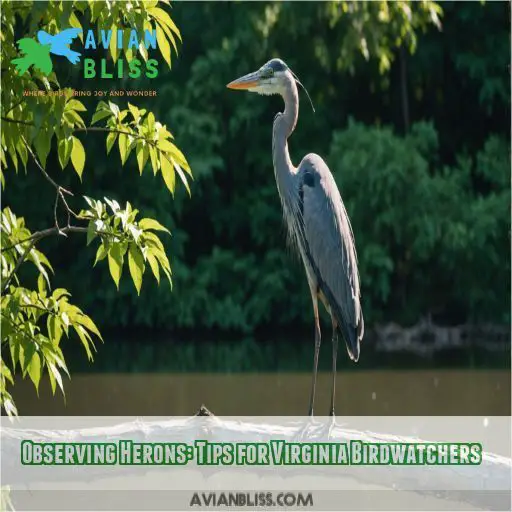This site is supported by our readers. We may earn a commission, at no cost to you, if you purchase through links.

From the towering Great Blue Heron to the elusive Yellow-crowned Night Heron, these long-legged waders are a sight to behold.
Herons in Virginia thrive in diverse habitats, from the Chesapeake Bay’s tidal marshes to inland rivers and man-made ponds.
They’re nature’s patient anglers, using clever hunting techniques to snag fish and amphibians.
Whether you’re a seasoned birder or just curious about local wildlife, spotting these graceful birds can be a real treat.
Keep your eyes peeled and your binoculars handy; you might catch a glimpse of these feathered celebrities striking a pose in Virginia’s wetlands.
Table Of Contents
Key Takeaways
- You’ll find five diverse heron species calling Virginia home, from the towering Great Blue Heron to the elusive Yellow-crowned Night Heron. These feathered celebrities are nature’s patient anglers, using clever hunting techniques that will make you wish you had their focus during your last fishing trip.
- Virginia’s herons are habitat all-stars, thriving everywhere from the Chesapeake Bay’s tidal marshes to your neighbor’s backyard pond. They’re like the ultimate wetland snowbirds, with some species sticking around all year while others jet off to warmer climes when winter hits.
- You can be a heron hero by joining Citizen Science programs. It’s like becoming a secret agent for conservation, collecting valuable data on heron populations while getting up close and personal with these majestic birds. Just remember, no tuxedos are required – camouflage works better!
- When you’re out heron-watching, remember to keep your distance and resist the urge to feed them. It’s like offering a stranger a mystery sandwich – not cool! Instead, pack a long lens for your camera and let your patience pay off with amazing shots and happy herons.
Common Heron Species in Virginia
You’re in for a treat if you’re looking to spot herons in Virginia. The Old Dominion State is home to five stunning heron species that’ll have you reaching for your binoculars faster than you can say "wading bird.
Great Blue Heron: Habits and Habitat
You’ll find the Great Blue Heron standing tall in Virginia’s wetlands, like a feathered sentinel.
These majestic birds, with their long legs and S-shaped necks, are masters of patience.
They’ll wait motionless for hours, ready to strike at unsuspecting fish.
During breeding season, they build massive stick nests high in trees, forming noisy colonies called rookeries.
Keep an eye out for their graceful flight along rivers and coastlines!
Green Heron: Identification and Behavior
While the Great Blue Heron might steal the spotlight, don’t overlook its smaller cousin, the Green Heron.
You’ll spot these compact birds hunched near water’s edge, their deep green backs and chestnut necks blending seamlessly with vegetation.
They’re nature’s little magicians, using bait to lure fish!
Listen for their distinctive "skeow" call, and you might catch a glimpse of their clever hunting techniques in action.
Black-crowned Night Heron: Nocturnal Adaptations
As night falls, you’ll witness a whole new world of heron activity.
The Black-crowned Night Heron takes center stage, its red eyes gleaming in the darkness.
These nocturnal ninjas have incredible eyesight, perfect for spotting fish in low light.
Their ghostly "kwok" calls echo through the swamps, while their mottled gray plumage acts like nature’s camouflage.
Watch them hunt with patience, striking faster than you can blink!
Little Blue Heron: Rare Sightings and Distribution
You’re in for a treat if you spot a Little Blue Heron in Virginia!
These elegant birds are a rare sight, mainly found in the state’s coastal areas.
They’re like nature’s hidden gems, preferring secluded wetlands and marshy spots.
Keep your eyes peeled for their slate-blue plumage and piercing yellow eyes.
Their presence is a good sign for local ecosystems, but they face challenges from habitat loss.
Yellow-crowned Night Heron: Coastal Populations
You’ve gotta see the yellow-crowned night heron to believe it!
These coastal beauties are real night owls, strutting their stuff along Virginia’s shores.
They’re not just pretty faces, though – they’re tough cookies dealing with coastal threats.
Their nesting habits and food sources are a birdwatcher’s dream.
Keep an eye out for population trends and conservation efforts – every sighting counts!
Heron Habitats Across Virginia’s Diverse Ecosystems
You’ll find Virginia’s herons in a stunning array of habitats, from the tidal marshes of Chesapeake Bay to inland rivers and freshwater swamps. Whether you’re exploring coastal lagoons or checking out a local pond, these long-legged waders have adapted to thrive in the state’s diverse aquatic ecosystems.
Chesapeake Bay: Tidal Marshes and Shorelines
Now, let’s wade into the Chesapeake Bay, where herons truly shine.
You’ll find these long-legged beauties strutting through tidal marshes like they own the place.
And in a way, they do! These wetlands are nature’s buffet for herons, teeming with fish and crustaceans.
Keep your eyes peeled along the shorelines too; you might spot a heron’s impressive stick nest perched high in a nearby tree.
Inland Rivers: Riparian Zones and Floodplains
Moving inland from the Bay, you’ll find herons thriving along Virginia’s rivers.
These waterways are like nature’s highways for our feathered friends.
Riverbank vegetation provides perfect perches for hunting, while nearby trees offer cozy nesting spots.
Keep an eye out for herons wading in shallow waters or patiently stalking fish from a fallen log.
It’s a real-life game of hide-and-seek, with herons as the masters of camouflage!
Freshwater Wetlands: Swamps and Marshes
Moving inland from rivers, you’ll find Virginia’s freshwater wetlands teeming with life.
These swamps and marshes are like all-you-can-eat buffets for herons!
Picture a great blue heron stalking through cattails, its keen eyes scanning for tasty morsels.
The rich plant life and biodiversity of these ecosystems make them prime real estate for our long-legged friends.
It’s no wonder herons often choose these spots for nesting and raising their young.
Coastal Lagoons and Salt Marshes
Venturing to Virginia’s coast, you’ll find herons thriving in salt marshes and coastal lagoons.
These unique ecosystems are nature’s nurseries, teeming with life.
You might spot a Great Blue Heron perched on a weathered piling, eyeing the shallow waters.
Salt marsh restoration efforts are giving these birds a helping hand, ensuring their nesting sites remain protected.
It’s a delicate balance, but one that’s important for our long-legged friends.
Man-made Ponds and Reservoirs
While natural habitats are important, don’t overlook man-made ponds and reservoirs. These artificial oases can be heron hotspots, offering a front-row seat to their antics. Imagine this:
- A great blue heron, still as a statue, eyeing its reflection
- A green heron, tip-toeing along the water’s edge
- Herons gathering at dusk, silhouetted against the setting sun
- A little blue heron, out of place but thriving
- Your local fishing spot, now a heron’s buffet
These waterways, while human-made, create key habitats and showcase heron adaptability.
Heron Hunting Techniques and Feeding Behaviors
You’re about to witness nature’s most patient predators in action. Virginia’s herons are masters of the wait-and-strike technique, using their long necks and sharp beaks to snag everything from fish to frogs in the blink of an eye.
Patient Stalking and Strike Methods
You’ve seen herons in their habitats, but have you ever wondered how they catch their meals?
These birds are the ninjas of the wetlands!
With the patience of a saint and the stealth of a shadow, herons are masters of the wait-and-strike game.
They’ll stand stock-still for what feels like ages, then – bam! – their long necks unfurl like lightning, nabbing unsuspecting prey in a flash.
Prey Species: Fish, Amphibians, and Invertebrates
You’ll be amazed by the diverse menu herons enjoy in Virginia’s waterways. These long-legged hunters aren’t picky eaters, feasting on a smorgasbord of aquatic life. Their diet changes with the seasons, showcasing nature’s delicate balance. Here’s a taste of what’s on the heron’s plate:
- Fish: From minnows to small bass
- Amphibians: Frogs, tadpoles, and salamanders
- Invertebrates: Crayfish, insects, and even small crabs
It’s like watching a live nature documentary in your backyard!
Adaptations for Aquatic Hunting
You’ve seen how herons hunt, but let’s talk about their incredible adaptations. These birds are built for aquatic hunting success! From their specialized beaks to their unique feet, herons are nature’s fishing experts. Check out this table of their amazing features:
| Adaptation | Purpose |
|---|---|
| Long, sharp beak | Spearing fish |
| Wide, flat feet | Stable wading |
| S-shaped neck | Quick strikes |
| Excellent eyesight | Spotting prey |
| Waterproof feathers | Staying dry |
These adaptations make herons true masters of their watery domain.
Seasonal Changes in Feeding Patterns
Herons are adaptable birds that change their diet with the seasons.
In winter, they often stick to smaller prey.
Come spring, fish start spawning, and herons are the first to feast.
During fall migration, they fuel up on whatever is abundant.
Herons enjoy a year-round feast, if you know where to look!
Heron Conservation and Environmental Indicators
You’ll be amazed to learn how herons serve as nature’s barometers, indicating the health of Virginia’s ecosystems. These elegant birds face challenges from habitat loss and climate change, but conservation efforts and citizen science programs are helping to protect their future in the Old Dominion.
Habitat Loss and Protection Efforts
You might not realize it, but Virginia’s herons are facing a crisis.
As we build more homes and businesses, their natural havens are shrinking fast.
But don’t lose hope! Conservation groups are teaming up with local communities to protect these majestic birds.
Water Quality and Heron Population Health
You might not think about it, but the health of Virginia’s herons is like a crystal-clear mirror reflecting the quality of our waterways.
These elegant birds are nature’s own water quality testers!
When pollution creeps in, heron populations take a hit.
It’s not just about dirty water, though – pesticides and habitat loss play their part too.
Climate Change Impacts on Virginia’s Herons
As you’ve seen, water quality impacts herons.
Climate change is throwing another curveball their way.
Rising sea levels are reshaping coastal habitats, forcing our feathered friends to adapt or move inland.
Warmer temperatures are also messing with their migration patterns and food availability.
It’s like Mother Nature’s playing a game of musical chairs, and our herons are scrambling to find a seat!
Citizen Science Programs for Heron Monitoring
You can be a heron hero!
Join citizen science programs and become part of Virginia’s conservation efforts.
These initiatives train volunteers like you to collect valuable data on heron populations.
It’s not just about numbers – you’ll learn to spot behaviors and track nesting sites.
Your observations contribute to real scientific research, helping protect these majestic birds.
Plus, you might make some feathered friends along the way!
Restoration Projects Benefiting Heron Populations
Restoration projects are breathing new life into Virginia’s heron habitats.
You’ll be thrilled to see wetlands and marshes coming back to life, thanks to dedicated efforts.
Local communities are rolling up their sleeves, working hand-in-hand with experts to restore these important ecosystems.
It’s not just about the birds—these projects are creating a ripple effect, benefiting countless species.
Want to get involved? There are plenty of opportunities to make a splash in heron conservation!
Observing Herons: Tips for Virginia Birdwatchers
You’re in for a treat if you’re planning to observe herons in Virginia. With the right knowledge and tools, you’ll be well-equipped to spot these magnificent birds in their natural habitats across the state’s diverse ecosystems.
Best Locations for Heron Spotting
Virginia is a heron-watcher’s paradise.
You’ll want to hit up the Chesapeake Bay’s tidal marshes, where Great Blues strut their stuff.
Don’t forget inland gems like the James River Park System in Richmond.
For a real treat, check out Chincoteague National Wildlife Refuge – it’s a veritable heron hotspot!
Local birding groups can point you to hidden gems, too.
Seasonal Patterns and Migration Behaviors
You’ll find Virginia’s herons dancing to nature’s rhythm throughout the year.
Spring brings breeding pairs to their nesting grounds, while fall sees them packing their bags for warmer climes.
Keep an eye on the skies in April and September for peak migration action.
Environmental factors like water levels and food availability can shake things up, so flexibility is key in your heron-watching adventures!
Equipment and Techniques for Heron Photography
Ready to snap some stunning heron shots? You’ll need the right gear and know-how.
A long lens (300mm+) is your best friend, letting you keep a respectful distance.
Set your camera to a fast shutter speed to freeze those lightning-quick strikes.
Early morning or late afternoon light works wonders, casting a golden glow on your feathered subjects.
Don’t forget to pack some camo so you’ll blend right in!
Ethical Guidelines for Heron Watching
Now that you’re geared up, let’s talk about being a responsible heron watcher.
Keep your distance to avoid heron disturbance, and never approach nests.
Resist the urge to feed them – it’s like offering a stranger a mystery sandwich.
When snapping photos, use that zoom lens instead of creeping closer.
Your patience will pay off with amazing shots and happy herons!
Joining Local Birding Groups and Tours
Ready to spread your wings and join the flock? Connecting with local birding groups and tours is your ticket to heron heaven! You’ll tap into a wealth of knowledge, make
Frequently Asked Questions (FAQs)
What sounds do herons make during mating season?
You’d be surprised! During mating season, herons don’t sing sweet love songs. Instead, they croak, squawk, and make guttural "frawnk" sounds. These harsh calls may not sound romantic to us, but they’re music to a heron’s ears!
How long do herons typically live in Virginia?
You’ll find herons living up to 15-20 years in the wild. They’re resilient birds, adapting well to Virginia’s diverse habitats. With good fortune and a bit of luck, some might even celebrate their silver jubilee!
Do herons migrate within or out of Virginia?
Like snowbirds flocking south, you’ll find herons in Virginia playing a game of "musical states." They’ll migrate within or out of Virginia, depending on the species. Great Blues often stick around, while others jet off for warmer climates.
Can herons be kept as pets in Virginia?
You can’t keep herons as pets in Virginia. It’s illegal to own wild birds without proper permits. Instead, why not try birdwatching? You’ll enjoy their beauty while respecting their freedom. It’s a win-win for nature lovers!
How do herons interact with other bird species?
You’ll find herons often keep to themselves, but they’re not total loners. They’ll mingle with other waders at feeding grounds. Watch out though – they can get a bit territorial when nesting time rolls around!
Conclusion
Virginia’s wetlands are a heron-watcher’s paradise.
You’ve now met the five majestic herons in Virginia that make our state’s waterways so fascinating.
From the stately Great Blue to the secretive Yellow-crowned Night Heron, these birds offer endless opportunities for observation and wonder.
So grab your binoculars, head to a nearby marsh, and prepare to be amazed.
Who knows? You might just fall in love with these long-legged anglers and become Virginia’s next great heron enthusiast!








